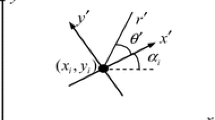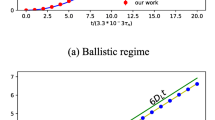Abstract
In this paper, we perform flexible and reliable dynamics simulations on different sizes of two or more particles’ interactive motions, where they encounter positive or negative dielectrophoresis (DEP) forces. The particles with identical or non-identical size are in close proximity suspended freely in a solution under a homogeneous electric field. According to the description of classic dipole moment, DEP forces make the particles form a straight chain. Therefore, dynamics simulation based on Newton’s laws is utilized to understand AC DEP phenomena among multiple particles. To solve the relevant governing equations, Stokes drag and repulsive forces (including wall and particles) are combined with DEP forces to obtain the trajectories of particles. Results show that particles with the same sign of the Clausius–Mossotti (CM) factor revolve clockwise or counterclockwise to attract each other parallel to the electric field direction. Conversely, the particle chain is perpendicular to the field. This programmable advantage is of great benefit to the study of three or four particle motions. Meanwhile, the pearl chain consisting of three or four particles is related not only to an individual CM factor but also to initial spatial configuration. Both the cluster and short chain are dependent on symmetry between the geometric distribution and electric field, while it implies different size particles easily cause the chain structure with less time.















Similar content being viewed by others
References
Pethig, R.: Dielectrophoresis: status of the theory, technology, and applications. Biomicrofluidics 4, 1–35 (2010)
Zhou, T.Y., Ming, Y.X., Perry, S.F., Tatic-Lucic, S.: Estimation of the physical properties of neurons and glial cells using dielectrophoresis crossover frequency. J. Biol. Phys. 42, 571–586 (2016)
Ho, C.T., Lin, R.Z., Chang, W.Y., Chang, H.Y., Liu, C.H.: Rapid heterogeneous liver-cell on-chip patterning via the enhanced field-induced dielectrophoresis trap. Lab Chip 6, 724–734 (2006)
Lin, R.Z., Ho, C.T., Liu, C.H., Chang, H.Y.: Dielectrophoresis based-cell patterning for tissue engineering. Biotechnol. J. 1, 949–957 (2006)
Ahadian, S., Naito, U., Surya, V.J., Darvishi, S., Estili, M., Liang, X.B., Nakajima, K., Shiku, H., Kawazoe, Y., Matsue, T.: Fabrication of poly(ethylene glycol) hydrogels containing vertically and horizontally aligned graphene using dielectrophoresis: an experimental and modeling study. Carbon 123, 460–470 (2017)
Singh, B., Wang, J., Rathi, S., Kim, G.H.: Alignment of graphene oxide nanostructures between microgap electrodes via dielectrophoresis for hydrogen gas sensing applications. Appl. Phys. Lett. 106, 1–5 (2015)
Hilding, J.M., Hong, M.P.L., Grulke, E.A.: Alignment of dispersed multiwalled carbon nanotubes in low strength AC electrical fields. J. Nanosci. Nanotechnol. 5, 742–746 (2005)
Hossan, M.R., Dillon, R., Roy, A.K., Dutta, P.: Modeling and simulation of dielectrophoretic particle–particle interactions and assembly. J. Colloid Interface Sci 394, 619–629 (2013)
Ai, Y., Qian, S.Z.: DC dielectrophoretic particle–particle interactions and their relative motions. J. Colloid Interface Sci. 346, 448–454 (2010)
Ai, Y., Zeng, Z.P., Qian, S.Z.: Direct numerical simulation of AC dielectrophoretic particle–particle interactive motions. J. Colloid Interface Sci. 417, 72–79 (2014)
Jones, T.B., Washizu, M.: Multipolar dielectrophoretic and electrorotation theory. J. Electrost. 37, 121–134 (1996)
Juarez, J.J., Bevan, M.A.: Interactions and microstructures in electric field mediated colloidal assembly. J. Chem. Phys. 131, 1–9 (2009)
Camarda, M., Fisicaro, G., Anzalone, R., Scalese, S., Alberti, A., Via, F.L., Magna, A.L., Ballo, A., Giustolisi, G., Minafra, L., Cammarata, F.P., Bravata, V., Gorte, G.I., Russo, G., Gilardi, M.C.: Theoretical and experimental study of the role of cell–cell dipole interaction in dielectrophoretic devices: application to polynomial electrodes. Biomed. Eng. Online 13, 1–10 (2014)
Kang, S.: Dielectrophoretic motions of multiple particles under an alternating-current electric field. Eur. J. Mech. B Fluids. 54, 53–68 (2015)
Hu, S., Zhao, Y., Yang, Y.: Modeling of cellular pearl chain formation using a double photoconductive layer biochip. J. Electrost. 77, 110–115 (2015)
Xie, C.C., Liu, L., Chen, B., Wu, J.K., Chen, H., Zhou, X.P.: Frequency effects on interactive motion of dielectrophoretic particles in an AC electrical field. Eur. J. Mech. B Fluids. 53, 171–179 (2015)
Xie, C.C., Chen, B., Liu, L., Chen, H., Wu, J.K.: Iterative dipole moment method for the interaction of multiple dielectrophoretic particles in an AC electrical field. Eur. J. Mech. B Fluids. 58, 50–58 (2016)
Xie, C.C., Chen, B., Wu, J.K.: Three-dimensional interaction of a large number of dense DEP particles on a plane perpendicular to an AC electrical field. Micromachines. 8, 1–16 (2016)
Gutierrez, M.A., Khanbareh, H., van der Zwaag, S.: Computational modeling of structure formation during dielectrophoresis in particulate composites. Comput. Mater. Sci. 112, 139–146 (2016)
Liu, L., Xie, C.C., Chen, B., Chiu-On, N., Wu, J.K.: A new method for the interaction between multiple DEP particles: iterative dipole moment method. Microsyst. Technol. 22, 2223–2232 (2016)
Liu, L., Xie, C.C., Chen, B., Wu, J.K.: Numerical study of particle chains of a large number of randomly distributed DEP particles using iterative dipole moment method. J. Chem. Technol. Biotechnol. 91, 1149–1156 (2016)
Belijar, G., Valdez-Nava, Z., Diaham, S., Laudebat, L., Jones, T.B., Lebey, T.: Dynamics of particle chain formation in a liquid polymer under ac electric field: modeling and experiments. J. Phys. D. Appl. Phys. 50, 1–8 (2017)
Hu, S., Zhao, Y., Lv, J.T., Si, G.Y.: Numerical model of carbon nanotubes based on lateral-field optoelectronic tweezers. Mol. Simul. 43, 638–643 (2017)
Zhu, X.L., Yin, Z.F., Ni, Z.H.: Dynamics simulation of positioning and assembling multi-microparticles utilizing optoelectronic tweezers. Microfluid. Nanofluid. 12, 529–544 (2012)
Moncada-Hernandez, H., Nagler, E., Minerick, A.R.: Theoretical and experimental examination of particle–particle interaction effects on induced dipole moments and dielectrophoretic responses of multiple particle chains. Electrophoresis 35, 1803–1813 (2014)
Weng, P.Y., Chen, I.A., Yeh, C.K., Chen, P.Y., Juang, J.Y.: Size-dependent dielectrophoretic crossover frequency of spherical particles. Biomicrofluidics 10, 1–11 (2016)
Parthasarathy, M., Klingenberg, D.J.: Electrorheology: mechanisms and models. Mater. Sci. Eng. R. Rep. 17, 57–103 (1996)
Acknowledgements
Author Sheng Hu received research grants from the Youth Foundation of Hebei Province under Grant F2017501059, the Doctoral Scientific Research Foundation of Liaoning Province under Grant 20170520325 and the Fundamental Research Funds for the Central Universities under Grant N172304033. Author Rongrong Fu received research grants from the Youth Foundation of Hebei Province under Grant E2018203433.
Author information
Authors and Affiliations
Corresponding author
Ethics declarations
Conflict of interest
The authors declare that they have no conflicts of interest.
Electronic supplementary material
Rights and permissions
About this article
Cite this article
Hu, S., Fu, R. Expanding the flexibility of dynamics simulation on different size particle–particle interactions by dielectrophoresis. J Biol Phys 45, 45–62 (2019). https://doi.org/10.1007/s10867-018-9514-7
Received:
Accepted:
Published:
Issue Date:
DOI: https://doi.org/10.1007/s10867-018-9514-7




